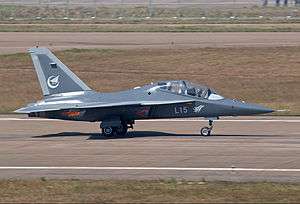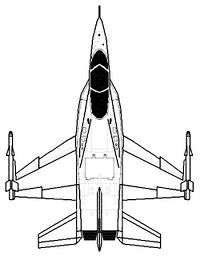Hongdu JL-10
The Hongdu JL-10 also known as the L-15 Falcon (猎鹰) is a supersonic advanced training and light combat aircraft being developed by Nanchang-based Hongdu Aviation Industry Corporation (HAIC) to meet the Chinese People's Liberation Army Air Force (PLAAF) and People's Liberation Army Naval Air Force (PLANAF) lead-in fighter trainer (LIFT) requirements, as well as next-generation training and light combat needs for foreign customers.[2]
| JL-10 (L-15) | |
|---|---|
 | |
| Role | Supersonic Advanced trainer/light combat |
| Manufacturer | Hongdu Aviation Industry Corporation |
| First flight | 13 March 2006 |
| Introduction | 2010[1] (at least 3 prototypes) |
| Status | In service |
| Primary user | People's Liberation Army Air Force |
| Unit cost |
US$ 15 million[2] |
.jpg)
Design and development
The JL-10 is an advanced trainer aircraft developed by Nanchang based Hongdu Aviation Industry Corporation. The aircraft made its maiden flight on 13 March 2006. The aircraft's general designer is Mr. Zhang Hong (张弘), and development had reportedly been completed alongside Yakovlev OKB of Russia. The JL-10 is a direct rival to the Guizhou Aircraft Industry Corporation (GAIC) JL-9/FTC-2000 Mountain Eagle in competition for the People's Liberation Army Air Force's (PLAAF) next-generation advanced trainer aircraft program.
HAIG unveiled a full-scale mock-up of its early prototype the L-15 advanced lead-in fighter trainer (LIFT) in the 2004 Zhuhai Airshow. The two-seat, two-engine L-15 featured the latest advanced technologies developed by China, such as the digital quadruple fly-by-wire (FBW), glass cockpit (two multi-color head down displays for both the front and rear cockpit, and an additional head-up display for the front cockpit) and hands-on-throttle-and-stick (HOTAS) flight control. The look-down field of view for the front cockpit is 18°, and 6° for the rear cockpit, exceeding the US requirement. The aerodynamic performance of the aircraft is enhanced by its large leading edge extensions (LEX) design, which gives a maximum angle of attack of 30°. This is very useful when trying to simulate the maneuvers of advanced fourth-generation fighters such as J-10, JF-17 and J-11, as well as for newest fifth generation fighter like J-20 and J-31. JL-9/FTC-2000 Mountain Eagle trainer jet from Guizhou Aircraft Industry Corporation (GAIC) is a direct competitor of the JL-10. JL-10 has a wide range of more advanced features comparing JL-9, but JL-9 is significant cheaper and its development and production would be fully indigenous, while early batches of JL-10 still rely on AI-222 series turbofan engine from Ukraine before an indigenous update is ready.[3]
With the JL-10, student pilots will be able to complete mission flight training and advanced combat training, as well as complete all basic jet flight training courses. The aircraft also has six (four under-wing and two wingtip) pylons to carry various air-to-air and air-to-ground weapons. If necessary, it can serve in the lightweight attack role with minor modifications, carrying up to 3.5 tons of armament.[4]
Each of the first two units (#01 & #02) are powered by two Ivchenko-Progress DV-2 engines, which do not have afterburners, and these two aircraft thus do not have the capability to reach supersonic speed. The third unit (#03) is powered by a pair of an improved version of the DV-2, the DV-2F, that has afterburners, so that it can attain supersonic speed. The subsequent production units are expected to be powered by Ukraine's Ivchenko-Progress AI-222K-25F turbofan engines with afterburners once a co-production license is obtained by the 608 Institute. Ivchenko-Progress was able to increase the thrust of the AI-222-28F (thrust 4500 kg afterburning) and AI-222-30F (5000 kg thrust afterburning) engines. The latter two engines may be used to equip the JL-10 or other Chinese aircraft.[5] Meanwhile, according to various Chinese reports, JL-10s with updated Guizhou FWS-17 engines had already undergone test flights.[4]
In June 2013, the AJT condition of L-15 finalized the design and would be operated by PLAAF with a formal name JL-10.[6] On July 1, 2013, the first batch of JL-10 began delivery to the PLAAF. Chinese Air Force and later Naval Air Force are highly satisfied with the aircraft's all-around performance, high reliability, cost-effectiveness, as well as its great multi-role update potentials, easy maintainability, and a service life of over 10,000 flying hours.[7][8]
Variants
- L-15A: AJT
- JL-10: The designation in People's Liberation Army Air Force service.[9]
- L-15Z: The designation in Zambian Air Force.[10]
- L-15AW: Combat variant with 7 hardpoints.[11]
- L-15B: Combat variant with afterburning engines, 9 hardpoints and capability to launch beyond-visual-range PL-12 missile.[12][11]
Operators
- People's Liberation Army Air Force (First batch of JL-10 is commissioned in a training center of PLAAF in Eastern China, quantity is uncertain based from public information)
In November 2012, an order for twelve JL-10s by an unknown customer was announced, due to be delivered in 2013.[13] This batch of JL-10 began delivery to the customer on June 29, 2013.[14]
In August 2018, according to the photos in the article, at least twelve JL-10 have been delivered to Navy Aviation university.[15]
- Zambian Air Force - It was reported in 2014 that Zambia had ordered 6 L-15s for US$100 million[16] and deliveries have completed in 2017.[17] According to Chinese sources, Zambia had ordered at least another 6 L-15As and 12 L-15Bs.[2]
Potential customers
- Uruguayan Air Force is interested in acquiring eight L-15s. A team of officers was sent to China in August 2016 to evaluate the aircraft.[17] The invitation was coordinated for October 2011 in an invitation extended by CATIC to the FAU command to form a committee including Air Marshall W. Martínez and staff.[20]
Specifications (L-15 AJT)

Data from Military-Today[21](estimate) L-15A[4]
General characteristics
- Crew: 2
- Length: 12.27 m (40 ft 3 in)
- Wingspan: 9.48 m (31 ft 1 in)
- Height: 4.81 m (15 ft 9 in)
- Empty weight: 4,500 kg (9,921 lb)
- Gross weight: 6,500 kg (14,330 lb)
- Max takeoff weight: 9,800 kg (21,605 lb)
- Powerplant: 2 × Ivchenko-Progress AI-222K-25 afterburning turbofan engines
Performance
- Maximum speed: 1,729 km/h (1,074 mph, 934 kn)
- Maximum speed: Mach 1.4 (L15B)
- Range: 550 km (340 mi, 300 nmi) +
- Ferry range: 3,100 km (1,900 mi, 1,700 nmi)
- Service ceiling: 16,000 m (52,000 ft)
- Rate of climb: 200 m/s (39,000 ft/min)
Avionics
See also
Aircraft of comparable role, configuration and era
- AIDC T-5 Brave Eagle
- Alenia Aermacchi M-346 Master
- Boeing T-7 Red Hawk
- Guizhou JL-9
- KAI T-50 Golden Eagle
- Yakovlev Yak-130
References
- "Hongdu JL-10 / L-15 Falcon Advanced Jet Trainer / Light-Attack Aircraft - China". Militaryfactory.com.
- 2017-04-14 17:55:45 (2017-04-14). "赞比亚购6架后又追加20架:仅售不到两千万的中国"猎鹰"_手机网易网". 3g.163.com. Retrieved 2019-03-21.CS1 maint: numeric names: authors list (link)
- "L15 and JL9 trainer jet competition, China PLAAF". AirForceWorld.com. Archived from the original on 2011-11-28. Retrieved 29 Aug 2011.
- sina_mobile (2018-08-27). "我军教练10研发路途一波三折 曾险因发动机问题下马_手机新浪网". Mil.sina.cn. Retrieved 2019-03-21.
- "Archived copy". Archived from the original on 2015-07-02. Retrieved 2015-06-29.CS1 maint: archived copy as title (link)
- "Archived copy". Archived from the original on 2013-06-20. Retrieved 2013-06-30.CS1 maint: archived copy as title (link)
- "Archived copy". Archived from the original on 2013-07-04. Retrieved 2013-07-01.CS1 maint: archived copy as title (link)
- "1个月交付7架,洪都在卯足了劲制造猎鹰高级教练机!_手机搜狐网". M.sohu.com.
- "The Chinese Air Force is about to get a swarm of fighter jets for training pilots". Popular Science.
- Donald, David. "China's L-15 Jet Displayed by Zambia In South Africa". Aviation International News.
- Waldron, Greg (6 November 2018). "AVIC burnishes combat credentials of L-15 family". Flight Global. Zhuhai. Archived from the original on 7 November 2018. Retrieved 7 November 2018.
- Waldron, Greg (1 November 2016). "Airshow China : AVIC advanced trainers in the spotlight". Flightglobal.com. Retrieved 21 March 2019.
- "L-15s Sold". Air International. Vol. 84 no. 1. January 2013. p. 15.
- "Archived copy". Archived from the original on 2013-07-06. Retrieved 2013-06-30.CS1 maint: archived copy as title (link)
- "海军航空大学已装备教练10,飞上航母培养舰载机飞行员指日可待". www.sohu.com. 2018-08-04. Retrieved 2018-08-13.
- Fisher, Richard D., Jr. (30 December 2015). "Zambia to receive first Hongdu L-15 trainer". Jane's Defence Weekly. Surrey, UK: Jane's Information Group. 53 (8). ISSN 0265-3818.
- Chuanren, Chen. "Uruguay Interested in Chinese L-15 Trainer". Aviation International News.
- "Pakistan Eyes Acquisition of Chinese Training Aircraft - Defense News…". archive.is. 28 July 2012. Archived from the original on 28 July 2012.
- "Archived copy". Archived from the original on 2014-11-19. Retrieved 2014-11-15.CS1 maint: archived copy as title (link)
- "CATIC invita a una delegación de la Fuerza Aérea uruguaya a China para evaluar aviones de combate - Noticias Infodefensa América". Infodefensa.com. 13 September 2011.
- "Hongdu L-15 Advanced Trainer". Military-today.com.
- "Archived copy". Archived from the original on 2015-11-22. Retrieved 2015-10-23.CS1 maint: archived copy as title (link)
External links
| Wikimedia Commons has media related to HAIG L15. |
- L-15 at Chinese Defence Today (in English)
- L15 Falcon Trainer Jet introduction - AirForceWorld.com (in English)
- First flight of L-15 03 (with pictures) (in Chinese)
- News article on the maiden flight of the L-15 (with pictures) (in Chinese)
- Incomplete recording of development history for L-15 (with pictures) (in Chinese)